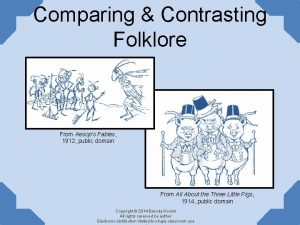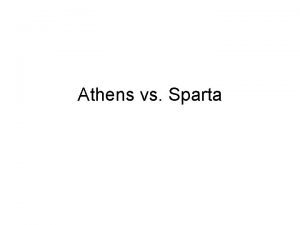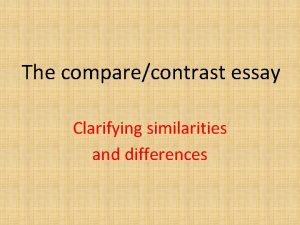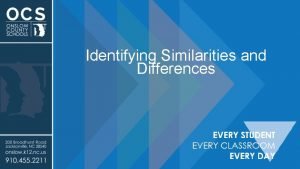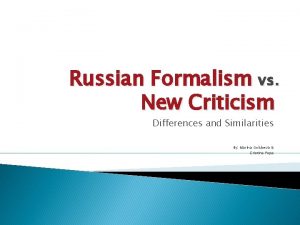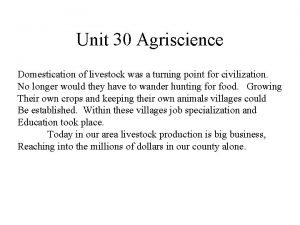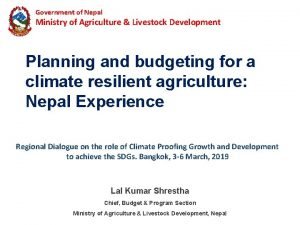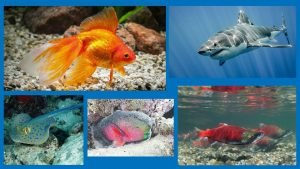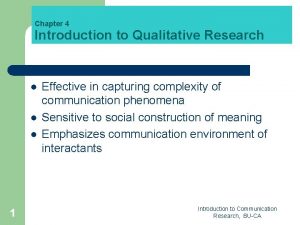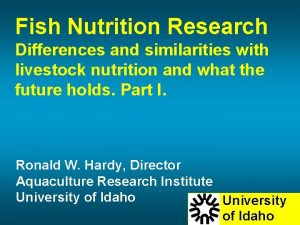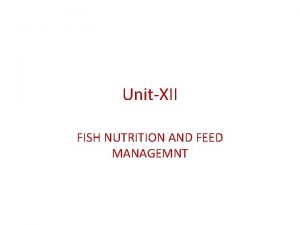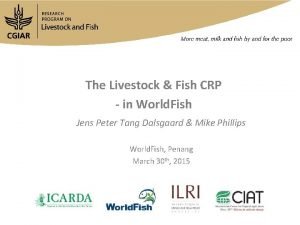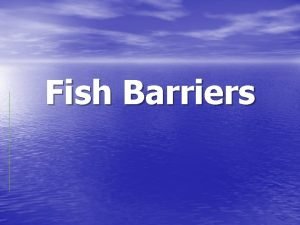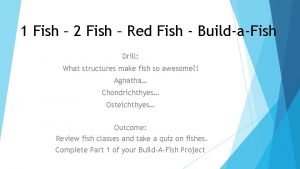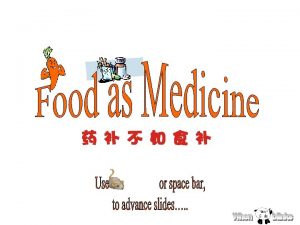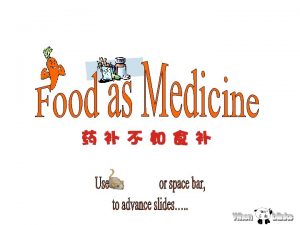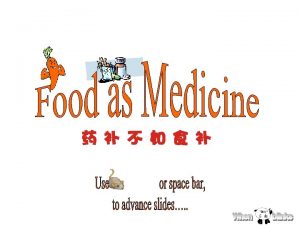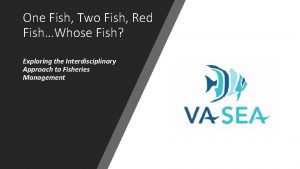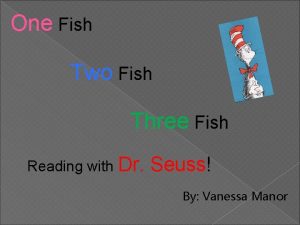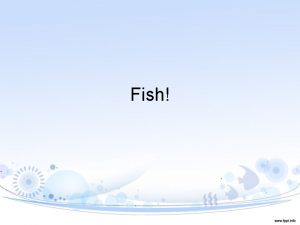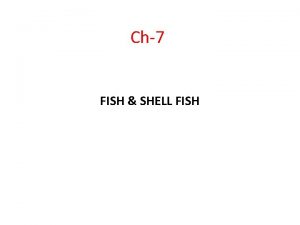Fish Nutrition Research Differences and similarities with livestock
































- Slides: 32

Fish Nutrition Research Differences and similarities with livestock nutrition and what the future holds. Part I. Ronald W. Hardy, Director Aquaculture Research Institute University of Idaho

Topics to cover • • • Differences between fish and livestock • Today’s hot topics in fish nutrition Brief history of fish nutrition Brief overview of evolution of fish feed manufacturing – – – • Replacement of marine protein and oils Effects of nutrition on food quality and fish health Microparticulate feeds for small fish larvae at first feeding Opportunities presented by developments in molecular biology

Fish Facts • Fish evolved in a very diverse environment, and 20, 000 species exploit every possible niche • Currently, there are ~140 species fish being farmed • • First publication on fish farming was 2500 BC • Aquaculture production growing at 9 -10% annually, fastest sector of animal production In 2005, 43% of all fish consumed globally was produced by farming

Differences among farmed fish species • Marine, brackish and freshwater fish • Coldwater and warmwater fish – Differences in osmotic cost to maintain homeostasis – O 2 content in water, plus availability of natural food in ponds compared trout raceways or marine net-pens • – metabolic rate and temperature tolerances – membrane fluidity that influences fatty acid requirements Fish and crustaceans (shrimp, crabs) – Huge differences in mechanisms of locating feed – Shrimp are external masticators, fish gulp feed – Differences in digestive physiology – Feeds must be water-stable for slow eaters like shrimp

Fish vs. livestock and poultry • Major differences associated with aquatic existence – Fish maintain neutral buoyancy and do not need skeletal and muscular systems to oppose gravity • – Fish excrete ammonia – Fish are cold-blooded Other differences – Fish exhibit indeterminate growth – Huge differences in digestive system among farmed fish • Fish are monogastric, but… – Gastric stomached fish (carnivores like salmon/trout) – Agastric (carp)


Fish vs. livestock and poultry: differences associated with aquatic existence • Fish exist in neutral gravity, no need for heavy skeleton – Dietary calcium and phosphorus needs are lower – Energy expenditures for locomotion are lower • Fish excrete ammonia via the gills – Lower metabolic cost than excreting urea or uric acid – Higher caloric energy yield from metabolism of amino acids • Fish are cold-blooded – Upside: no need to stay warm – Downside: rates of metabolism, digestion, etc. decrease in cooler water, plus membrane fluidity must change

Fish vs. livestock and poultry: differences in physiology • Many fish exhibit indeterminate growth – Growth continues after first maturation and spawning – Hypertrophy and hyperplasia (make new muscle cells) • Fish are monogastric (few herbivorous fish) – Some fish have an acid stomach – Other start with an acid stomach, then lose it as fingerlings – Some are stomach-less (agastric)

Fish vs. livestock and poultry: differences at start of exogenous feeding • Some fish spawn large eggs – Salmon & trout (2000 -15, 000 eggs/female) – Incubation requires 50 -100 days depending on water temperature – First feeding fry are 200 -400 mg and can be fed small, particulate feed • Many fish spawn very small eggs – Most marine species (> 1 million small eggs per female) – Incubation requires 3 -7 days – First feeding fry are very small and must be fed live-feed through metamorphosis or until reach a decent size – It is very challenging to provide adequate nutrition via live feed • • Right live feed at the right time Correct nutritional content of live prey ( need PUFA enrichment)

Cod eggs

Copper rockfish larvae at first feeding

Canary rockfish larvae with feed in gut six weeks after first feeding stage

Fish vs. livestock and poultry: other nutritional differences • Fish nutritional requirements – Ascorbic acid – Polyunsaturated fatty acids (PUFAs) – Many minerals obtained via the water • Carnivorous species have a limited ability to utilize or metabolize starch – They evolved using protein and lipid for metabolic energy

Efficiency of fish compared to livestock • • FCR values less than 1. 0 for fish • Total yield from poultry or cattle is lower and quality varies with cut FCR values 1. 6 -1. 8 for chickens FCR values 8 -10 for cattle Yield of high-quality protein from salmonids is 55%

Brief history of fish nutrition • Prior to 1950 s: –empirical feed formulation research with a variety of ingredients –Nutritional diseases quite prevalent –Little solid information on nutritional requirements • 1950 s and 60 s: –“Golden age” due to development of semi-purified diet that allowed single nutrients to be deleted and added back (Halver’s Ph. D work) –Vitamin and amino acid requirements of salmon and trout were discovered –Common nutritional diseases eliminated

Brief history of fish nutrition • 1970 s : –Essential nutrient list expanded to other species –Refinement of nutrient requirement estimates using new approaches to assess nutritional adequacy • 1980 s and 90 s: Aquaculture production takes off • 2000 until now – Need for economical and efficient grow-out feeds – New species including those with larval stages – Low-pollution feeds (low-phosphorus, highly digestible) –Main story is alternative protein and lipid sources –Sub-plot is supplements to enhance disease resistance, provide “semi-essential nutrients” and to produce healthful products (low in POPs, high in omega-3 fatty acids)

Dietary nutrient requirements: Pioneering fish nutrition research • Development of semi-purified diet (1953) that supported normal growth • Establishment of quantitative dietary requirements of vitamins & amino acids (1960 s) – USFWS Western Fish Nutrition Laboratory • John Halver & colleagues • Pacific salmon were focus, hatchery support • all work was conducted with fry & fingerlings

Vitamin requirements of salmon and growing chickens (IU or mg/kg dry diet) Vitamin A Vitamin D Vitamin E Vitamin K Thiamin Riboflavin Pyridoxine Pantothenic acid Niacin Biotin Folic acid Vitamin B 12 Ascorbic acid Choline myo-Inositol Salmon/trout 2500 2400 50 unknown 1 7 6 20 10 0. 15 2 0. 01 50 800 300 *values in yellow are lower for chickens Chickens 1500 200 16 0. 5 1. 3 3. 6 3. 0 10 11 0. 10 0. 25 0. 003 not required 500 not required

Semi-purified diet for salmonids Ingredient Percent in diet Vitamin-free casein Gelatin Dextrin Wheat starch Carboxymethylcellulose Alpha-cellulose Mineral mixture Vitamin mixture Amino acid mixture Choline chloride (70% liquid) Herring oil 40. 0 8. 0 10. 0 1. 3 6. 0 4. 0 3. 0 2. 0 0. 3 17. 0 Proximate category Percent Moisture 28 -30 Crude protein 34 Fat 17 Ash 5

Determining nutrient requirements in fish • Feed semi-purified diet, adding back graded levels of single essential nutrient • measure response variables – growth, feed conversion ratio, survival (1950’s) – tissue nutrient levels, assuming that they plateau at requirement level (1950’s through today) – measure activity of enzymes that require essential nutrient as co-factor (same assumption, 1980’s) – – measure excretion of nutrient or metabolites (1990’s) Nutrigenomics (study of effects of nutrients on gene expression and single gene products in tissues)

Qualitative dietary arginine requirement (Halver)

Relationship between thiamin intake and liver thiamin concentration

Nutrient requirements of salmonids • • • Protein Ten essential amino acids Lipids Omega-3 fatty acids (1% of diet) Energy Supplied mainly from lipids and protein • • • Vitamins 15 essential vitamins Minerals Carotenoid pigments 10 minerals shown to be essential Needed for viable eggs • NOTE: Other minerals are probably essential but can be obtained from rearing water

Criteria or method used to establish a dietary vitamin requirement affects value • • • Response variable – absence of deficiency sign (minimum level) – tissue saturation or plasma level – enzyme activity Statistical evaluation – broken-line (Almquist plot) – curve-fitting and models • fit curves but are they biologically relevant? • do we chose 95% or 100% response as requirement? Real-world environmental conditions – crowding, water quality, pathogen load etc.

Ascorbic acid requirements of salmonids Requirement* Comments 15 -20 ppm Prevents deficiency signs 250 -500 ppm Supports maximum wound healing activity 1000 -2500 ppm Supports maximum disease resistance in laboratory challenges >2500 ppm Maximum tissue storage levels and max. immune response * When included in purified diet, with ideal conditions and no oxidation of vitamin C

Mineral requirements of fish Macrominerals (g/kg diet) Microminerals (mg/kg diet) (trace elements) Calcium Phosphorus* Sodium Potassium* Chlorine Magnesium* Sulfur Iron Manganese* Copper Zinc* Cobalt Selenium* Iodine* Molybdenum * Required in the diet, but not always supplemented in practical feeds

Carotenoid pigments in farmed salmon and trout feeds Synthesized products Carophyll red Carophyll pink Natural products Krill meal Phaffia yeast Marine algae Crustacean waste (crab, shrimp, crayfish) Note: astaxanthin shown to be essential nutrient for salmon to produce viable offspring

Nutrient requirements – Halver’s contribution • Complete estimates of nutrient requirements only done for juvenile Pacific salmon and rainbow trout • Halver’s work never duplicated for Atlantic salmon –Dietary requirements still based on Pacific salmon work • Atlantic salmon production – >1, 200, 000 metric tons – ~2, 000 metric tons of salmon and trout feed per year • The nutritional information upon which this industry is based is that of Halver and his colleagues

Changes in protein and fat levels in trout feeds

Changes in protein and fat levels in salmon feeds

Changes in feed conversion ratios for salmon and trout

The authoritative text for all fish nutritionists
 One fish two fish red fish blue fish ride
One fish two fish red fish blue fish ride One fish two fish blowfish blue fish
One fish two fish blowfish blue fish All vertebrates
All vertebrates Parents and offspring
Parents and offspring Ppst domains and strands
Ppst domains and strands Venn diagram of ant and grasshopper
Venn diagram of ant and grasshopper Compare sparta and athens
Compare sparta and athens Raymond's run characters
Raymond's run characters What is wad in gender
What is wad in gender Compare/contrast definition
Compare/contrast definition Cross cultural differences and similarities
Cross cultural differences and similarities Identifying similarities and differences
Identifying similarities and differences Marzano similarities and differences
Marzano similarities and differences Describe the similarities between fascism and communism
Describe the similarities between fascism and communism Identifying similarities and differences examples
Identifying similarities and differences examples My hogs by kayla afinson
My hogs by kayla afinson Table of similarities and differences
Table of similarities and differences Comparison and contrast paragraph examples
Comparison and contrast paragraph examples Similarities of historical criticism and formalism
Similarities of historical criticism and formalism Similarities and differences table
Similarities and differences table Identifying similarities and differences
Identifying similarities and differences Similarities and differences
Similarities and differences A big fish swims up and swallows a small fish at rest
A big fish swims up and swallows a small fish at rest Cattle egrets and livestock
Cattle egrets and livestock Livestock breed identification: swine - vocabulary
Livestock breed identification: swine - vocabulary Ministry of agriculture and livestock development
Ministry of agriculture and livestock development Diagram of male and female reproductive system of fish
Diagram of male and female reproductive system of fish Spiracles in fish
Spiracles in fish Market form of shellfish
Market form of shellfish Conclusive research example
Conclusive research example Similarities between qualitative and quantitative research
Similarities between qualitative and quantitative research Similarities between qualitative and quantitative research
Similarities between qualitative and quantitative research Similarities of qualitative and quantitative research
Similarities of qualitative and quantitative research





